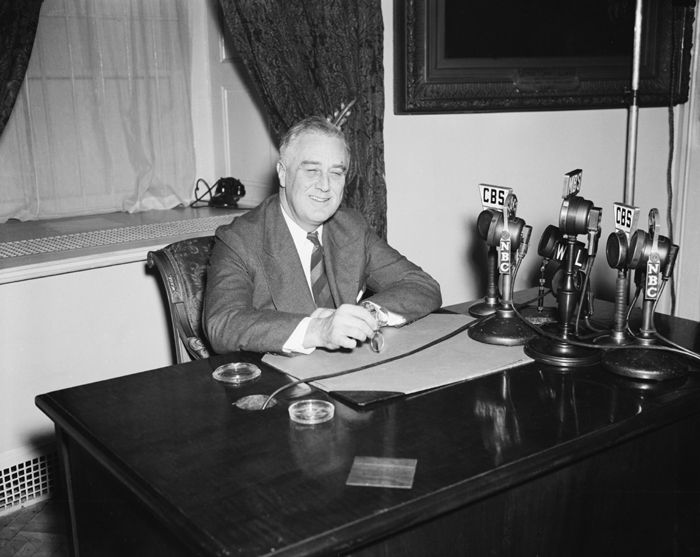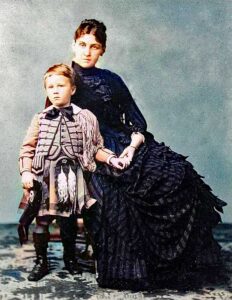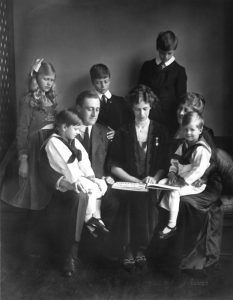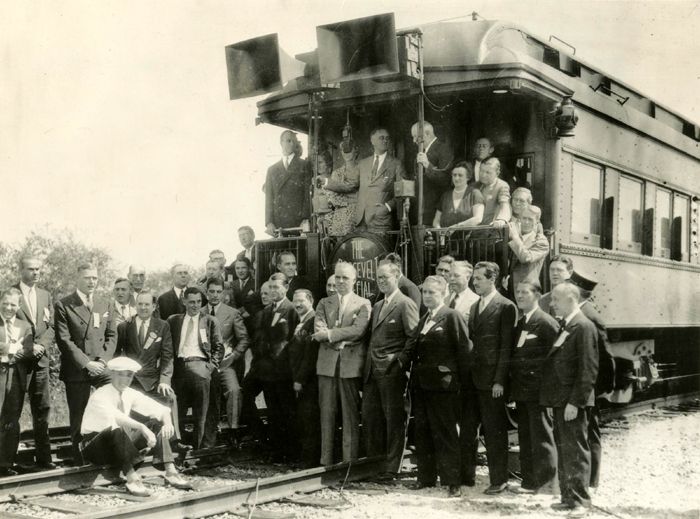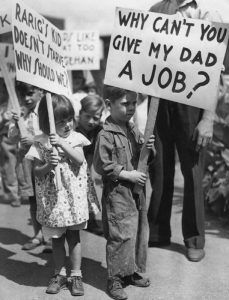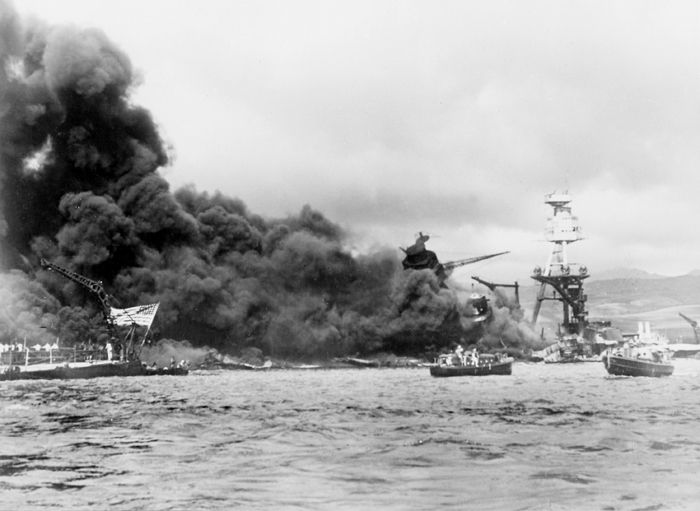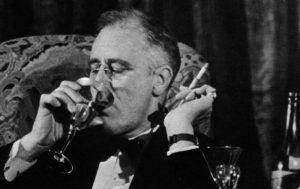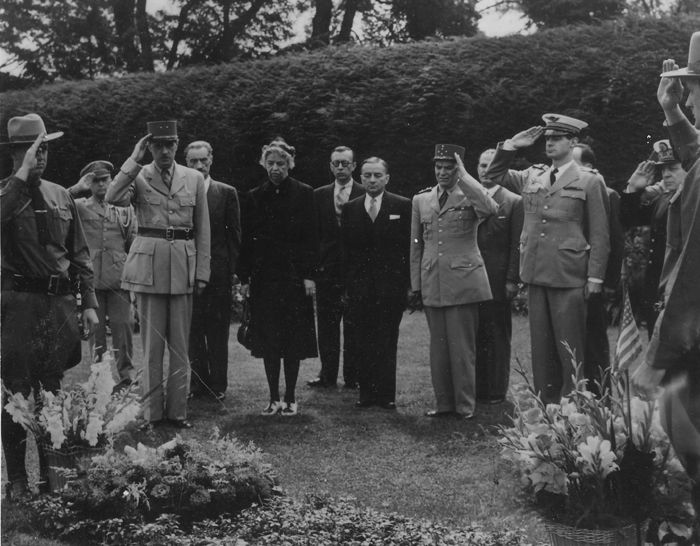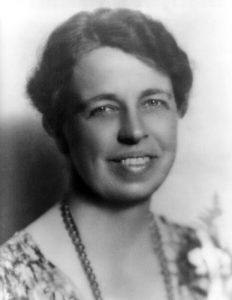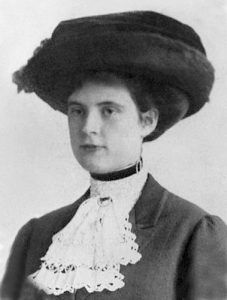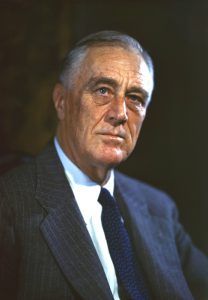The only thing we have to fear is fear itself.
— Franklin D. Roosevelt
Franklin Delano Roosevelt, often referred to by his initials FDR, was a Democratic statesman and political leader who served as the 32nd president of the United States from 1933 until he died in 1945. He directed the federal government during most of the Great Depression, implementing his New Deal domestic agenda in response to the worst economic crisis in U.S. history.
Franklin Roosevelt was born on his family’s estate on the Hudson River in Hyde Park, New York, on January 30, 1882, to businessman James Roosevelt and his second wife, Sara Delano Roosevelt. Both his parents came from wealthy old New York families who were well-educated and prominent members of New York society. Franklin’s father purchased the 110-acre estate in 1867 and named it Springwood. Young Franklin would spend much of his life on the estate and eventually be buried there. It is a National Historic Site today.
The only child from his father’s second marriage to Sara Delano, young Franklin was doted on by his mother and lived a privileged life. In addition to their estate in Hyde Park, the Roosevelts also had a house in New York City and summered on Campobello Island in New Brunswick, Canada. As a young boy, Franklin made frequent European trips and became fluent in German and French. As a youth, he learned to ride, shoot, row, and play polo, lawn tennis, and golf. He learned to sail, and his father gave him a sailboat when he was 16.
His parents and private tutors provided him with his early education, some of which took place in Germany at the age of nine. From 1896 to 1900, he attended Groton School, a prestigious preparatory school in Groton, Massachusetts, and afterward, he received a B.A. degree in history from Harvard in 1903.
In the meantime, Franklin’s father died in 1900, and his fifth cousin, Theodore Roosevelt, became President of the United States in 1901. Theodore’s vigorous leadership style and ambitious reforms made him Franklin’s role model and hero.
On March 17, 1905, Franklin married his fifth cousin, Eleanor Roosevelt, whom he had been courting since 1902. Eleanor was the niece of Theodore Roosevelt, and the pair had known each other since childhood. The couple married in New York City, and Eleanor’s uncle, President Theodore Roosevelt, stood for Eleanor’s deceased father at the wedding. Franklin’s mother, Sara, who was very possessive of her son, fiercely resisted the marriage because she thought Franklin was too young. However, she did not dislike Eleanor, and despite her feelings, she invited the couple to live with her on the Springwood estate in Hyde Park when the marriage took place. Sara also built a pair of townhouses in New York City, one for Franklin and Eleanor and another next door for herself. Franklin and Eleanor would eventually have six children, five of whom survived infancy.
The same year he was married, Franklin entered New York’s Columbia University to study law. After passing the bar examination in 1907, he left school without taking a degree. Afterward, he practiced law with a prominent New York City law firm for three years.
In 1910, he entered politics and was elected to the New York State Senate as a Democrat in 1912. After supporting Woodrow Wilson’s candidacy, he was appointed the Assistant Secretary of the Navy in 1913, a position he held until 1920. After doing well in this position, he was nominated for vice president by the Democratic Party in 1920 on a ticket headed by James M. Cox of Ohio. However, Cox lost to Republican Warren Harding, and Roosevelt returned to private life.
While vacationing in New Brunswick, Canada, in the summer of 1921, Roosevelt contracted polio and was left permanently paralyzed from the waist down. He then sought refuge at Springwood, where his strength slowly returned. After much rehabilitation and with the encouragement and help of his wife, Eleanor, and other leaders, he soon resumed his political career. In 1928, he was elected the governor of New York.
In the meantime, the Great Depression had begun, and Roosevelt made bold efforts to combat it in New York, enhancing his reputation. He soon began to campaign for the presidency, and in 1932, he won the nomination as the Democratic Party candidate for president. He campaigned energetically, calling for government intervention in the economy to provide relief, recovery, and reform. His activist approach and charm helped defeat Herbert Hoover in November 1932 by seven million votes. This would be the first of four terms in which Roosevelt would serve.
Franklin Roosevelt took the oath of office on March 4, 1933. During the four months between Roosevelt’s election and his inauguration, the Depression worsened. By then, there were 13,000,000 unemployed, and almost every bank was closed. Of those that remained open, withdrawals were restricted. Farm income had fallen by over 50%, and an estimated 844,000 non-farm mortgages had been foreclosed on. Industrial production had plummeted, and the pace of factory closings accelerated. Roosevelt faced the greatest crisis in American history since the Civil War.
In his first “hundred days,” he proposed. Congress enacted his New Deal programs to alleviate the suffering of the nation’s massive number of unemployed workers, bring recovery to business and agriculture, and relief to the unemployed and to those in danger of losing farms and homes, change the financial system, and other reforms to propel the nation out of its Depression. Banks reopened within a very short time, and direct relief saved millions of people from starvation.
The New Deal program was based on “socialistic” tendencies that the federal government’s power was needed to get the country out of the Depression. Although public support was widespread, not everyone agreed with Roosevelt’s agenda, arguing that the federal government had no place spending millions on public works, going into debt, and regulating business and industry. Others thought the New Deal did not go far enough and that the federal government should control the banks and industry. Roosevelt responded with new reform programs, including Social Security, heavier taxes on the wealthy, new controls over banks and public utilities, and an enormous work relief program for the unemployed.
Roosevelt easily defeated Alfred M. Landon in 1936 and went on to defeat by lesser margins, Wendell Willkie in 1940 and Thomas E. Dewey in 1944. He thus became the only American president to serve more than two terms.
By 1939, World War II had broken out in Europe, and Roosevelt concentrated increasingly on foreign affairs. At this time, New Deal reform legislation diminished, though the ill effects of the Depression would not fully abate until the nation mobilized for war. In the early years of the war, the United States remained neutral, though aid was provided to Britain, France, and China. However, when France fell in 1940, Roosevelt’s policy changed dramatically, and Congress enacted a draft for military service.
The Japanese surprise attack on Pearl Harbor, Hawaii, on December 7, 1941, changed everything. The very next day, Congress declared war against Japan. Three days later, Germany and Italy declared war against the United States, and Congress, voting unanimously, reciprocated. This brought the nation fully into the global struggle.
During the war, priority was given to the Western European front; by April 1945, victory in Europe was inevitable. The war officially ended with an invasion of Germany by the Western Allies and the Soviet Union, culminating in the capture of Berlin by Soviet troops, the suicide of Adolf Hitler, and the German unconditional surrender on May 8, 1945.
But, by that time, President Franklin D. Roosevelt would be dead. The unending stress and strain of the war had worn him out.
In early 1944, a complete medical examination disclosed that Roosevelt had severe heart and circulatory problems and was placed on a strict diet and medication regime. Roosevelt, a chain-smoker throughout his adult life, had been in declining physical health since at least 1940.
In March 1944, he underwent further testing and was found to have high blood pressure, atherosclerosis, coronary artery disease, and congestive heart failure. Hospital physicians, specialists, and his doctor ordered Roosevelt to rest, and changes to his schedule were made to accommodate this. However, his declining physical health was kept secret, and Roosevelt clarified that he was seeking another term. When it was time for the 1944 Democratic National Convention and re-election campaign, his doctor declared, “The President’s health is perfectly OK. There are absolutely no organic difficulties at all.” When it came time for the election in November 1944, Roosevelt and his vice-presidential running mate, Harry S. Truman, won by a comfortable margin.
Within months of his fourth term election, Roosevelt looked old, thin, and frail. On March 29, 1945, he traveled to the Little White House, a personal retreat in Warm Springs, Georgia. On the afternoon of April 12, Roosevelt said, “I have a terrific headache,” before slumping forward in his chair, unconscious. He was then carried to his room, and his attending cardiologist, Dr. Howard Bruenn, diagnosed the medical emergency as a massive stroke. He died just two and one-half hours later without regaining consciousness. He was 63 years old and just three months into his fourth term.
His death was met with shock and grief across the United States and worldwide. The next day, his body was placed in a flag-draped coffin and loaded onto the presidential train for the trip back to Washington, D.C. Along the route, thousands flocked to the tracks to pay their respects. After a White House funeral on April 14, Roosevelt was transported by train to his estate at Hyde Park, New York, where he was buried in the Rose Garden on April 15.
After Germany surrendered the following month, newly-sworn in President Truman dedicated Victory in Europe Day and its celebrations to Roosevelt’s memory and kept the flags across the U.S. at half-staff for the remainder of the 30-day mourning period, saying that his only wish was “that Franklin D. Roosevelt had lived to witness this day.”
World War II finally came to a complete end with the surrender of Japan in September following the atomic bombings of Hiroshima and Nagasaki. Truman would preside over demobilizing the war effort and establishing the United Nations and other postwar institutions envisioned during Roosevelt’s presidency.
Today, Franklin Delano Roosevelt is considered one of the most influential figures in the history of the United States. Historians and political scientists often rank him as one of the three greatest presidents, along with George Washington and Abraham Lincoln.
Others, however, adamantly disagree. During his presidency, and continuing to a lesser extent afterward, there has been much criticism of Roosevelt. Critics question his rapid expansion of government programs that redefined the role of the government and his breaking with tradition by running for a third term as president. He also increased the power of the presidency at the expense of Congress. During his presidency, some of his programs were declared by the Supreme Court to be unconstitutional, but many, like Social Security, became permanent parts of the American political system.
After his death, his widow, Eleanor, was a forceful presence in politics, serving as a delegate to the conference that established the United Nations and championing civil rights and liberalism. Many members of his administration played leading roles in the administrations of Presidents Truman, Kennedy, and Johnson, each of whom embraced Roosevelt’s political legacy.
Roosevelt was the first and only president to serve more than two terms. Until then, two terms had been the tradition established by George Washington when he refused to run for a third term in the 1796 presidential election. Every other president after him, up until Roosevelt, had followed Washington’s lead until Roosevelt. Afterward, Congress passed the Twenty-Second Amendment, which limits an elected president to two terms in office in 1947. The states ratified it in 1951.
Though it was not widely known until the 1960s, Roosevelt had several extra-marital affairs. According to one biographer, this was perhaps because Eleanor had an aversion to sexual intercourse and considered it “an ordeal to be endured.” The primary affair was with Eleanor’s social secretary, Lucy Mercer, which began soon after she was hired in 1914. After several years, Eleanor found letters revealing the affair in Roosevelt’s luggage in 1918.
Though Eleanor offered Franklin a divorce, and Franklin considered accepting, his mother, Sara, strongly objected because it would end his political career and threatened to cut him off from the family fortune. Further, Lucy would not agree to marry a divorced man with five children. Afterward, Franklin promised never to see Lucy again, and the couple remained married but became more of a political partnership. In fact, Eleanor established a separate home in Hyde Park at Val-Kill, and increasingly devoted herself to various social and political causes independently of her husband. The couple never “officially” lived together again. When Roosevelt was president, he was often unaware of her visiting the White House. Roosevelt, in turn, did not visit Eleanor’s New York City apartment until late 1944. The emotional break in their marriage was so severe that when Roosevelt was in failing health in 1942 and asked Eleanor to return home and live with him again, she refused.
After the affair was discovered, Lucy Mercer married wealthy socialite Winthrop Rutherfurd, a widower then in his fifties, in 1920. However, the two remained in secret contact for several decades despite Franklin’s promise to Eleanor and her marriage to another man. When he died, Lucy Mercer Rutherfurd was at Roosevelt’s retreat home in Warm Springs, Georgia. But, she was quickly whisked away to avoid negative publicity and the implications of infidelity.
Roosevelt’s son Elliott also claimed that his father had a 20-year affair with his private secretary, Marguerite “Missy” LeHand. Another son, James, stated that “there is a real possibility that a romantic relationship existed” between his father and Crown Princess Märtha of Norway, who resided in the White House during part of World War II. At that time, aides referred to her as “the president’s girlfriend,” and gossip linking the two romantically appeared in the newspapers.
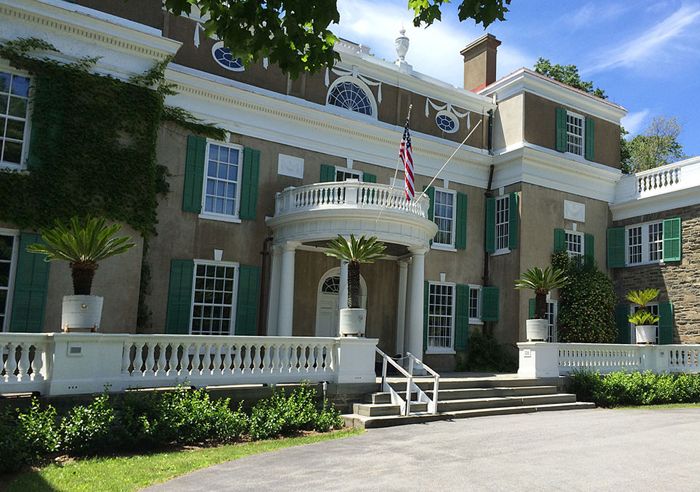
Roosevelt’s Springwood Estate in Hyde Park, New York, is now a National Historic Site, courtesy of Wikipedia.
The Springwood family estate in Hyde Park, New York, where Roosevelt was born and was buried, was given to the United States. Today, it is a National Historic Site, which has remained unchanged since his death. The house is still full of his personality, including his boyhood collection of stuffed birds.
© Kathy Alexander/Legends of America, updated January 2024.
Also See:
President Franklin D. Roosevelt’s “Infamy Speech“
President Roosevelt’s New Deal
Sources:
Franklin D. Roosevelt Library and Museum
National Park Service
Whitehouse.gov
Wikipedia

